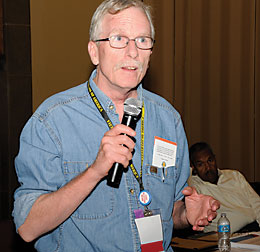 |
||||||||||||
|
2016 VVA Leadership & Education Conference, September/October 2016 Veteran Suicide and Risk Prevention PRESENTED BY TOM HALL AND TOM BERGER
Suicide also is not done from anger or revenge, even if someone leaves behind a note saying so. And it is certainly not done on impulse. Suicide takes planning. One must have time to become dulled to the idea of no longer being. To overcome the natural fear of death a person has to work toward obliterating that fear and has to find a way to become desensitized to dying. A person comes to such an empty place one step at a time. This planning takes at least a year for most people. Many of those who commit suicide take care of finances, living spaces, wills, and goodbyes before they die. They do not wish to be a burden after death, either. Thousands of people in mental pain take drugs or drink to excess. They do this not to die, but to self-medicate, to try and feel better, or to feel nothing at all. Death, then, is the inadvertent result of trying to dull emotional pain. Guilt is a major cause of suicide. War causes people to do things they’ve been taught not to do. Guilt over taking life makes taking one’s own life easier. Veterans have seen horrors that civilians can’t imagine. From the grunt who had to kill to survive, to the transport guys who had to give rides to the same mutilated or dead grunts, horror lives in them. Traumatic brain injury is hell to live with. So is sexual assault, male or female. Fifty-seven percent of veterans who have recurring nightmares commit suicide. They don’t sleep well, which allows toxins to build up in their brains. Nightmares are not flashbacks. They are sometimes worse, though flashbacks alone can make people want to die. There are other warning signs, such as talking about wanting to die or about hopelessness and being without purpose. Some people feel trapped because they are in unbearable physical or mental pain. Potential suicides talk about what a burden they are to others, and they may chronically sleep too much—or not enough. They may be especially anxious, agitated, reckless, or enraged, or even want to take serious revenge on people. There is at least one suicide every thirteen minutes in this country. Men are four times more likely to succeed, but women try more often. That’s changing, however, because women veterans know how to use weapons. Veterans, overall, succeed more than anyone else. According to the VA 65 percent of all veterans in 2014 who committed suicide were fifty years or older. Kind words help; so do letters or cards, though none is a guarantee. Suicidal people are not looking for pity or sympathy but for real, constructive help. “Tough love” is a misguided concept at best, while its opposite, pity and sympathy, are weak gifts to someone in intense pain—and may make the person feel there is no hope. These are gifts on which nothing can be built. Pity may even be taken for condescension. Being straight, being honest, and being real are better strategies. Depression and confusion severe enough to cause suicidal thoughts are not insurmountable. The latest brain research has shown that the brain is plastic, that nothing in there is written in stone. The physical mass of wrinkled matter is not really what makes the brain work. It is the neurons, which can be made to integrate one’s terrible isolation and emotional pain so that they are like any other memory. New therapies can rewire the brain to feel differently about experiences, no matter how horrific they are. If you know someone contemplating suicide, do not leave that person alone. Remove dangerous objects: guns, pills, ropes. Take the person to an emergency room or seek the help of medical or mental health professionals. We can find help, we can learn to understand what is going on with people who are suicidal. We can learn what it is they really want and need. The earlier we support them, the better. —Loana Hoylman
|
||||||||||||
|
|
||||||||||||
|
||||||||||||
8719 Colesville Road, Suite 100, Silver Spring. MD 20910 | www.vva.org | contact us |
||||||||||||





















 There are more myths about suicide than there are actual facts. The biggest myth is that suicide is cowardice. It is, in fact, an act of courage and generosity in the minds of those who die this way. They feel they are too much of a burden to others and that they cannot be helped. Suicide is not a selfish act.
There are more myths about suicide than there are actual facts. The biggest myth is that suicide is cowardice. It is, in fact, an act of courage and generosity in the minds of those who die this way. They feel they are too much of a burden to others and that they cannot be helped. Suicide is not a selfish act.